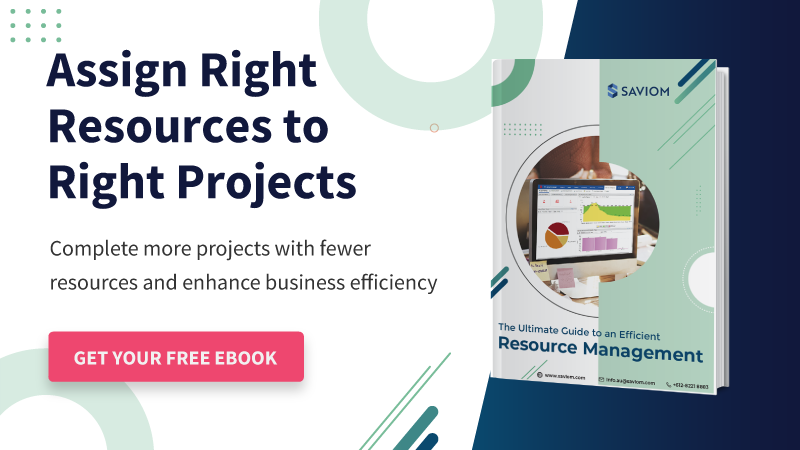People often misconstrue the duties of a resource manager and a human resource manager and use these job titles interchangeably. However, there is a significant difference in their roles and responsibilities.
A resource manager ensures the billability of resources across the enterprise, whereas a human resource manager streamlines hiring and nurtures talent based on the organization’s needs.
Resource managers have to coordinate and work closely with HR managers. They first coordinate with project managers and PMOs to understand the resource requirements. Then, if there is a resource crunch, they work alongside the HR managers, explain the resource requirements, and initiate the hiring process.
Thus, resource management and HR management are two sides of the same coin that are established to maintain and enhance the resource health index. This blog distinguishes between resource and HR management and explains the roles and responsibilities of the respective managers.
Addressing the first question,
What differentiates resource management from HR management?
Resource management
Resource management is the process of utilizing several types of business resources effectively and efficiently. In other words, it is a process that allows managers to tap into the maximum potential of their workforce. These resources span from human resources, assets, facilities, equipment, etc. In addition, it aims to fulfill project demands on or before its onset to ensure timely delivery and within budget. This can be done by allocating resources ahead of time, either from the available talent pool or recruiting a new workforce.
The major components of resource management include resource forecasting, capacity planning, scheduling, bench management, and decision-making using real-time business intelligence. When implemented the right way, these functionalities enable managers to optimally utilize the workforce, reduce resourcing costs, improve resource health index, and enhance the business’s profitability and sustainability.
Read More: What is Resource Management? A Comprehensive Guide for All
Human resource management
Human resource management is the practice of developing formal systems to hire or recruit and manage an organization’s employees. The process encapsulates the creation, implementation, and supervision of work policies across the enterprise. The main objective of HRM is to manage employees within a workplace and reinforce the work culture to meet the company’s objectives and long-term vision.
Human resource management is carried out by HR professionals who are responsible for executing day-to-day functions. It includes making decisions about employees’ remuneration and benefits, conflict management, ensuring compliance with labor laws, strengthening employee relations, and promoting employee well-being.
In a nutshell, resource management aims to enhance the overall utilization of the workforce and ensure successful project delivery, whereas human resource management deals with the recruitment of the right talent and their adherence to the work policies and culture.
Let’s now understand the roles of resource and HR managers.
Roles of a resource manager
Resource managers have multiple tasks to accomplish, from ensuring competent resource allocation to maximizing productive utilization with constant monitoring and support. It’s easier to fulfill them when resources are present in co-located offices as opposed to being dispersed across geographical boundaries.
Thus, they can leverage resource management software to simplify all these processes and do justice to their roles and responsibilities.
Here is a rundown of some of the most significant tasks.
Implement resource planning and competent allocation
The primary responsibility of a resource manager is to streamline resource planning. It is the process of forecasting, identifying, allocating, and utilizing enterprise-wide resources effectively. To initiate this process, project managers first analyze the project requirements by assessing the project’s scope and then raise resource requests accordingly.
A resource manager analyzes these requests, identify and assigns resources whose skill set is aligned with the demand. Besides skills, managers also have to factor in various attributes like project budget, resource availability, location, band level, etc. In the absence of a particular skill set, resource managers initiate planned hiring well ahead of the curve to bridge the gap.
Bridge the capacity vs. demand gap
Resource managers are responsible for forward-planning pipeline projects by analyzing future resource demands and implementing the right measures to fill vacancies. They first assess the gap between the current capacity against demands and identify resource shortfalls/excess. Accordingly, they take the right resourcing treatments to bridge the capacity vs. demand gap.
If there is an excess of resources, it can be mitigated by bringing future project work ahead, adjusting timelines, redeployment of resource capacity in other projects, etc. On the other hand, in case of a shortfall of resources, a resource manager can implement out rotation and backfill strategy. They can also select any benched resource based on the skills or coordinate with HR managers to hire contingent or permanent employees.
Coordinate with project managers and fulfill resource requests
As mentioned earlier, before a project kicks off, the project manager raises resource requests systematically. Depending on that, the resource manager finds the best-fit resources for the open positions based on project priority. Sometimes, a project manager can also raise resource requests in a staggered manner due to changing client requirements.
In this scenario, the onus is on the resource manager to fulfill these requests on time without hampering the project timeline. Moreover, following project prioritization practices diligently help resource managers to allocate resources while minimizing power conflicts. They can equip a resource management tool to automate the requisition workflow and maintain an audit trail for better transparency.
Read More: Project Resource Management: An Ultimate Guide on How to Master it
Maximize billable and strategic utilization of resources
Resource utilization measures how efficiently resources are utilized against their total capacity. Resource scheduler lets managers view the resource’s allocation on billable, non-billable, and strategic work. At the same time, it also gives an overview of over and underutilized resources. Thus, based on the data, resource managers can implement remedial measures and optimize utilization.
For example, let’s say that more than half of a resource’s available capacity is booked on non-billable work. In that case, the resource managers can mobilize them to billable or strategic work and enhance their overall billability. Thus, it facilitates them to enhance productivity and optimize resource health index.
Ensure effective bench management
Bench refers to the section of a company’s employees who are not working on any project but are on the company’s payroll. Thus, the onus is on resource managers to minimize the bench size and protect the company’s revenue. Implementing the right resource management tool can help a resource manager achieve this and prevent the bench size from exceeding the threshold.
For instance, they can foresee a large-scale roll-off from a project using the tool and proactively allocate the employees to other tasks before they hit the bench. They can also consider project vacancies and initiate appropriate upskilling/training sessions to prepare benched resources for future demands. Furthermore, if experienced resources are on the bench, managers can find suitable strategic projects to utilize them for profitable work. They also provide shadowing opportunities for freshers to reduce the bench size after mass campus placements.
Manage resource-related risks
Resource-related risks are unexpected events that can impact projects or businesses negatively. In coordination with project managers, a resource manager assesses and eliminates these risks to avoid derailment of projects.
These risks include resource overallocation, increased employee burnout, lowered productivity, unplanned attrition, etc., all of which can impact the organization’s profitability.
For example, in case of unplanned attrition or prolonged absence of a critical resource, the project’s progress may suffer badly. Therefore, the resource manager can proactively identify any backup resource from the existing resource pool well in advance. In case if there are no resources available, they can also book generic resources for the pipeline projects and eventually coordinate with HR to hire a contingent or full-time replacement.
Read More: How to Mitigate Resource Risk in Project Management?
The following section emphasizes the duties and predominant tasks of an HR manager.
Roles of an HR manager
Facilitate the hiring process
HR managers streamline the entire recruitment process and ensure the selection of suitable candidates. They conduct the HR interview round and coordinate with the concerned department’s head to facilitate technical rounds. Further, their responsibility is to discuss and negotiate salary expectations with the candidates to reach a mutually agreeable figure. Besides, they also ascertain all the document-related work involved in hiring a new candidate is duly completed.
After onboarding, the HR manager organizes an orientation program to familiarize the new employee with the company’s work culture and policies. They also coordinate with the concerned domain leads to explain the employee’s roles and responsibilities. In short, the HR manager regulates the onboarding process right from the first interview round to the final appointment and onboarding.
Frame and implement work policies
Work policies form the foundation of an organization’s work culture. They help maintain the decorum at the workplace and standardize processes to reinforce values and keep everyone on the same page. The formation of these work policies falls under the umbrella of the HR manager’s responsibilities. They collaborate with stakeholders, understand the organizational objectives and needs, and draw out the policy framework accordingly.
They also assess these policies regularly, understand their impact on the work environment, and see whether they have served the intended purpose. Moreover, they also conduct feedback surveys to get an insight into employees‘ experience and any policy impeding their productivity. Based on survey responses, they amend the particular policy on rational grounds to enhance employee satisfaction and retention.
Read More: Ten Effective Strategies to Reduce Employee Turnover
Take care of compensation and benefits
An HR manager also administers compensation, which constitutes planning, organizing, and controlling all direct and non-direct payment forms for the work employees. Direct payment forms include base salary, premium payments for overtime, etc. Non-direct payment forms constitute health insurance, paid leaves, etc.
They also have to stay abreast of the current pay rates of every job role to comply with industry standards, maintain a competitive edge, and attract and retain talent. Additionally, HRs maintain equitable pay rates for similar job roles to ensure payroll consistency in the organization, mitigate pay-related conflicts, and reduce employee turnover.
Formulate appraisal process framework
Performance appraisal is one of the crucial processes to ensure employee engagement, productivity, and overall efficiency. Thus, forming this framework that caters to both employee and organizational needs is imperative. The HR managers accomplish this task as well and develop a customized framework. It includes deciding a suitable appraisal method, standardizing evaluation criteria, fixing rewards for exceptional performance, and more.
They coordinate and check in with the line managers to ensure that the fair practices of the appraisal system are followed uniformly across the organization. At the same time, HR managers ascertain that the appraisal methods align with the modern workplace trends. If not, they review and revisit this framework and revamp it in conformance with the current landscape.
Read More: What is Employee Performance Management and Why It is Important
Take disciplinary actions
Organizations define certain workplace norms and regulations to ensure smooth functioning and create necessary boundaries. An HR manager ensures that every employee abides by them. They also keep a tab on any cases of violation of workplace policies and take suitable disciplinary actions.
A disciplinary action is a reprimand against an instance of misconduct or policy violation. It can range from a verbal or written warning, demotion, or termination, to a legal suit in extreme cases, depending on the gravity of the violation. Thus, HR managers in coalition with the upper management take appropriate actions against such misdemeanors. For example, forming an anti-harassment cell to curb workplace misconduct is an HR manager’s responsibility.
Resolve conflicts
An HR manager plays an important role in resolving conflicts between different team members effectively and amicably. They encourage resources to understand and appreciate the differences between them and use them positively. Their role also comprises continuous observation of employees’ behavioral patterns.
If an HR manager notices any tension building up, they act proactively to prevent it from turning into an unmanageable dispute.
Besides, they also encourage employees to communicate their grievances and concerns freely and provide potential solutions to resolve the matter. Managers can take appropriate proactive measures to curb such incidents. For instance, given today’s diverse workforce, certain organizations and HR departments conduct diversity intelligence workshops to motivate employees to be inclusive and respectful.
Read More: 11 Ways to Improve Cross-Departmental Collaboration
The takeaway
Resource managers and HR managers are two different job titles with their own sets of roles and responsibilities. However, they both strive to achieve the common goal of enhancing workplace efficiency and sustaining a high-performance culture.
So, these departments must work cohesively and in sync. The better the synergy between them, the higher the overall productivity and profitability.
So, how do you manage the two departments efficiently for your company’s success?
The Glossary
Read More: Glossary of Resource Workforce Planning, Scheduling and Management
The SAVIOM Solution
SAVIOM has over 20 years of experience helping multinational clients manage their resources efficiently and effectively. With over 20 years of experience, this Australian-based MNC has a global presence across 50 countries and has helped 100+ clients meet their specific business goals. Saviom also provides tools for project portfolio management, professional service automation, and workforce planning software. So, SAVIOM can help your business to establish an efficient system geared towards your specific business challenges.













Leave a Reply